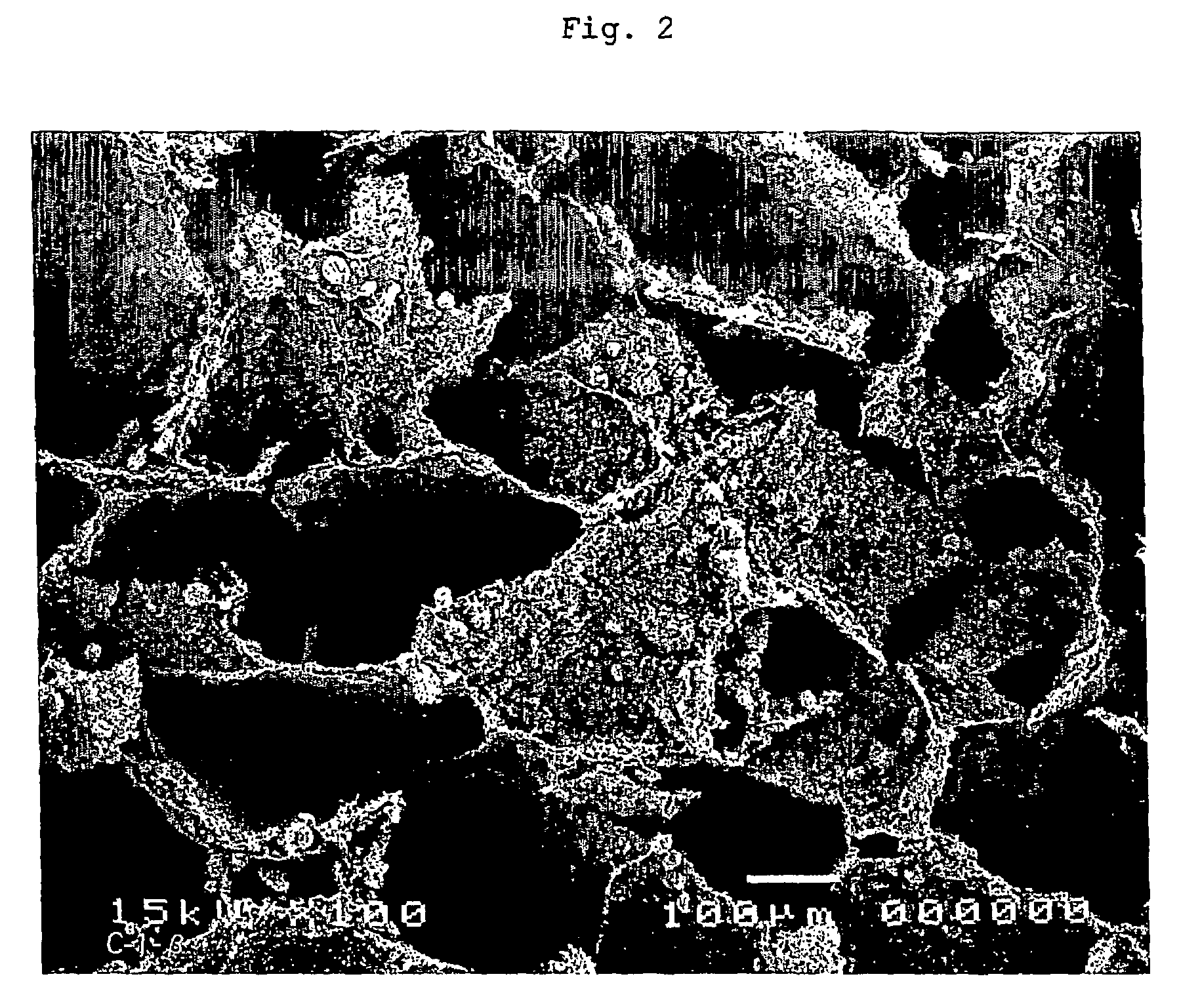Porous body, production method thereof and composite material using the porous body
a technology of porous body and fiber, which is applied in the direction of catalyst activation/preparation, synthetic resin layered products, and final product manufacturing. it can solve the problems of insufficient degree of three-dimensional network formation between fiber filaments, difficult design, and difficult preparation of prepregs of vapor grown carbon fiber. , to achieve the effect of low volumetric shrinkage, easy to manufacture and use, and easy to design
- Summary
- Abstract
- Description
- Claims
- Application Information
AI Technical Summary
Benefits of technology
Problems solved by technology
Method used
Image
Examples
example 1
[0098]Agar (1.5 g) was dissolved in purified water (50 g) under heating at 95° C., to thereby prepare a solution (the solution will be called “liquid A”). Separately, sodium dodecylbenzenesulfonate (concentration: 40 mass %, product of Aldrich) (0.45 g) was added to purified water (75 g). To the resultant mixture was added vapor grown carbon fiber (VGCF (registered trademark), product of Showa Denko K. K.; fiber diameter: 150 nm, aspect ratio: 60, specific surface area: 13 m2 / g, Raman spectrum intensity ratio: 0.15) (4.2 g). The resultant mixture was subjected to ultrasonic irradiation for 30 minutes, and then to stirring for one hour by use of a magnetic stirrer, to thereby prepare a dispersion (the dispersion will be called “liquid B”).
[0099]After being cooled to 60° C., the liquid A was mixed with the liquid B. Thereafter, the resultant mixture was frozen in a freezer at −15° C. to −20° C. Subsequently, the thus-frozen product was removed from the freezer, and placed in a freeze-...
example 2
[0101]The porous material produced in Example 1 was thermally treated in a tubular heating furnace under a stream of argon gas (10 L / min) at 800° C. for one hour. The thus-treated porous material was found to have a porosity of 0.98, a vapor grown carbon fiber content of 93 mass %, a specific surface area of 520 m2 / g, and a volume resistivity of 40 Ω·cm. The percent volumetric shrinkage of the porous material during thermal treatment was found to be 13 vol. %.
example 3
[0102]Agar (1.5 g) was dissolved in purified water (50 g) under heating at 95° C., to thereby prepare a solution (the solution will be called “liquid A”). Separately, sodium dodecylbenzenesulfonate (concentration: 40 mass %, product of Aldrich) (0.45 g) was added to purified water (75 g). To the resultant mixture was added vapor grown carbon fiber (VGCF (registered trademark), product of Showa Denko K. K.; fiber diameter: 150 nm, aspect ratio: 60, specific surface area: 13 m2 / g, Raman spectrum intensity ratio: 0.15) (8.5 g). The resultant mixture was subjected to ultrasonic irradiation for 30 minutes, and then to stirring for one hour by use of a magnetic stirrer, to thereby prepare a dispersion (the dispersion will be called “liquid B”).
[0103]After being cooled to 60° C., the liquid A was mixed with the liquid B. Thereafter, the resultant mixture was frozen in a freezer at −15° C. to −20° C. Subsequently, the thus-frozen product was removed from the freezer, and subjected to freeze...
PUM
| Property | Measurement | Unit |
|---|---|---|
| diameter | aaaaa | aaaaa |
| specific surface area | aaaaa | aaaaa |
| electrical resistivity | aaaaa | aaaaa |
Abstract
Description
Claims
Application Information
 Login to View More
Login to View More - R&D
- Intellectual Property
- Life Sciences
- Materials
- Tech Scout
- Unparalleled Data Quality
- Higher Quality Content
- 60% Fewer Hallucinations
Browse by: Latest US Patents, China's latest patents, Technical Efficacy Thesaurus, Application Domain, Technology Topic, Popular Technical Reports.
© 2025 PatSnap. All rights reserved.Legal|Privacy policy|Modern Slavery Act Transparency Statement|Sitemap|About US| Contact US: help@patsnap.com



